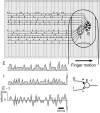Neural coding mechanisms underlying perceived roughness of finely textured surfaces
- PMID: 11517278
- PMCID: PMC6763072
- DOI: 10.1523/JNEUROSCI.21-17-06905.2001
Neural coding mechanisms underlying perceived roughness of finely textured surfaces
Abstract
Combined psychophysical and neurophysiological studies have shown that the perceived roughness of surfaces with element spacings of >1 mm is based on spatial variation in the firing rates of slowly adapting type 1 (SA1) afferents (mean absolute difference in firing rates between SA1 afferents with receptive fields separated by approximately 2 mm). The question addressed here is whether this mechanism accounts for the perceived roughness of surfaces with element spacings of <1 mm. Twenty triangular and trapezoidal gratings plus a smooth surface were used as stimulus patterns [spatial periods, 0.1-2.0 mm; groove widths (GWs), 0.1-2.0 mm; and ridge widths (RWs), 0-1.0 mm]. In the human psychophysical studies, we found that the following equation described the mean roughness magnitude estimates of the subjects accurately (0.99 correlation): 0.2 + 1.6GW - 0.5RW - 0.25GW(2). In the neurophysiological studies, these surfaces were scanned across the receptive fields of SA1, rapidly adapting, and Pacinian (PC) afferents, innervating the glabrous skin of anesthetized macaque monkeys. SA1 spatial variation was highly correlated (0.97) with human roughness judgments. There was no consistent relationship between PC responses and roughness judgments; PC afferents responded strongly and almost equally to all of the patterns. Spatial variation in SA1 firing rates is the only neural code that accounts for the perceived roughness of surfaces with finely and coarsely spaced elements. When surface elements are widely spaced, the spatial variation in firing rates is determined primarily by the surface pattern; when the elements are finely spaced, the variation in firing rates between SA1 afferents is determined by stochastic variation in spike rates.
Figures










References
-
- Cox DR, Lewis PAW. The statistical analysis of series of events. Methuen; London: 1966.
-
- Craig JC, Johnson KO. The two-point threshold: not a measure of tactile spatial resolution. Curr Dir Psychol Sci. 2000;9:29–32.
Publication types
MeSH terms
Grants and funding
LinkOut - more resources
Full Text Sources
Other Literature Sources
